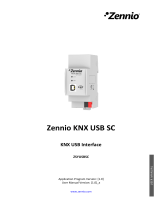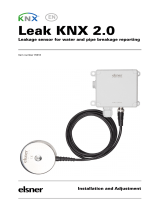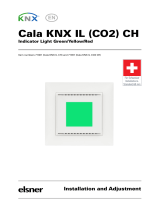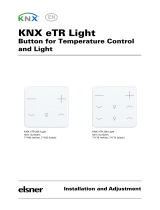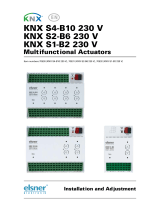Page is loading ...

MAXinBOX Hospitality
http://www.zennio.com Technical Support: http://support.zennio.com
2
CONTENTS
Contents ................................................................................................................................... 2
Document Updates ................................................................................................................... 3
1 Introduction ...................................................................................................................... 4
1.1 MAXinBOX Hospitality .................................................................................................. 4
1.2 Installation ................................................................................................................... 5
1.3 Start-Up and Power Loss .............................................................................................. 6
1.4 Status Indicators ........................................................................................................... 7
1.4.1 Binary and Shutter Outputs .................................................................................. 7
1.4.2 Fan Coil Control Outputs (Valve / Fan) .................................................................. 7
2 Configuration .................................................................................................................... 8
2.1 General ........................................................................................................................ 8
2.2 Inputs ......................................................................................................................... 10
2.2.1 Binary Input ........................................................................................................ 10
2.2.2 Temperature Probe ............................................................................................ 10
2.2.3 Motion Detector ................................................................................................. 10
2.3 Outputs ...................................................................................................................... 12
2.4 Fan Coil ...................................................................................................................... 13
2.5 Logic Functions ........................................................................................................... 14
2.6 Master Light ............................................................................................................... 15
2.7 Manual Control .......................................................................................................... 18
ANNEX I. Communication Objects ........................................................................................... 23

MAXinBOX Hospitality
http://www.zennio.com Technical Support: http://support.zennio.com
3
DOCUMENT UPDATES
Version
Changes
Page(s)
[2.3]_a
Changes in the application program:
Update of the Fan Coil module.
-
Changes in the document:
Clarification about the behaviour of disabled outputs in
Test On Mode.
21
[2.2]_a
Changes in the application program:
Update of the Logic Functions, Heartbeat, Binary
Inputs, Individual Digital Outputs, Motion Detector,
Temperature Probe and Fan Coil modules.
-
[2.1]_a
Changes in the application program:
Inclusion of the Heartbeat module.
Inclusion of the Shutter/Blind control module.
Update of the Logic Functions, Master Light Control
and Motion Detector modules.
-
[2.0]_a
Changes in the application program:
Three-point valve control.
New general status object in the Master Light module.
Possibility of controlling a third individual output.
Optimisation of the manual control function.
-
[1.1]_a
Changes in the application program:
Optimisation of the timed actions management in the
logic functions module.
Improvement of the inputs management (certain
configurations / combinations were leading to
occasional deviations in the readings).
Name change of certain fan control or valve control
objects.
-

MAXinBOX Hospitality
http://www.zennio.com Technical Support: http://support.zennio.com
4
1 INTRODUCTION
1.1 MAXINBOX HOSPITALITY
MAXinBOX Hospitality from Zennio is a versatile KNX multi-function actuator destined
to cover the climate control needs in KNX environments with integrated fan coil units
where both the fan speed and the opening of the water pipe valves are controlled by
relays.
At a glance, the most outstanding features of MAXinBOX Hospitality are:
2 multi-purpose relay outputs, configurable as:
Up to two binary outputs.
Up to one shutter channel.
Note: if a four-pipe fan coil with a three-point valve is configured, these two
outputs are used to control the valve.
2 relay outputs to control one three-point valve or up to two on-off
valves. One of these outputs can also be configured as an additional multi-
purpose relay output (in this case, for non-capacitive loads) in case it is not
necessary for the fan coil control.
3 relay outputs to control up to three fan levels.
6 multi-purpose inputs, each of them configurable as:
Temperature probe,
Binary input (i.e., pushbuttons, switches, sensors),
Motion detector.
10 customisable, multi-operation logic functions.
Master light control for an easy, out-of-the-box control of a set of luminaires
(or functionally equivalent devices) one of which acts as a general lamp and
the others as secondary lamps.
Manual operation / supervision of the relay outputs through the on-board
pushbuttons and LEDs.
Heartbeat or periodical “still-alive” notification.

MAXinBOX Hospitality
http://www.zennio.com Technical Support: http://support.zennio.com
5
1.2 INSTALLATION
MAXinBOX Hospitality connects to the KNX bus through the on-board KNX connector.
Once the device is provided with power from the KNX bus, both the individual address
and the associated application program may be downloaded.
This device does not need any additional external power since it is entirely powered
through the KNX bus.
Figure 1 MAXinBOX Hospitality Elements
The main elements of the device are described next.
Prog./Test Pushbutton (9): a short press on this button sets the device into
the programming mode, making the associated LED (8) light in red.
Note: if this button is held while plugging the device into the KNX bus, the
device will enter into safe mode. In such case, the LED will blink in red every
0.5 seconds.
Outputs (2, 5 and 6): output ports for the insertion of the stripped cables of
the systems being controlled by the actuator (see sections 2.3 and 2.4).
Please secure the connection by means of the on-board screws.
1. Multi-purpose Inputs.
2. Fan Control Outputs.
3. Output Status LED Indicator.
4. Manual Control Pushbutton.
5. Valve Control Outputs.
6. Multi-purpose Binary Outputs.
7. KNX Bus Connector.
8. Prog./Test LED.
9. Prog./Test Pushbutton.
9
4
1
6
7
3
8
5
2

MAXinBOX Hospitality
http://www.zennio.com Technical Support: http://support.zennio.com
6
Inputs (1): input ports for the insertion of the stripped cables of external
elements such as switches / motion detectors / temperature probes, etc. One
of the two cables of each element needs to be connected to one of the slots
labelled “1” to “6”, while the other cable should be connected to the slot
labelled as “C”. Note that all the external input devices share the “C” slot for
one of the two cables. Please secure the connection by means of the on-
board screws.
For detailed information about the technical features of the device and for safety
instructions or about the installation process, please refer to the corresponding
Datasheet, bundled with the original package of the device and also available at
www.zennio.com.
1.3 START-UP AND POWER LOSS
During the device start-up, the Prog./Test LED will blink in blue colour for a few
seconds before MAXinBOX Hospitality is ready. External orders will not be executed
during this time, but afterwards.
Depending on the configuration, some specific actions will also be performed during
the start-up. For example, the integrator can set whether the output channels should
switch to a particular state and whether the device should send certain objects to the
bus after the power recovery. Please consult the next sections of this document for
further details.
On the other hand, when a bus power failure takes place, MAXinBOX Hospitality will
interrupt any pending actions, and will save its state so it can be recovered once the
power supply is restored. In addition, the individual outputs will switch to the specific
state configured in parameters.

MAXinBOX Hospitality
http://www.zennio.com Technical Support: http://support.zennio.com
7
1.4 STATUS INDICATORS
Each of the outputs of MAXinBOX Hospitality incorporates a light indicator that reflects
its current state.
1.4.1 BINARY AND SHUTTER OUTPUTS
If an output is configured as binary, the LED indicator will only be on while the relay
remains closed; otherwise it remain off.
If configured as a shutter channel, the LED indicator will only remain on while the
shutter is in motion.
Please refer to section 2.3 for details about the relay outputs.
1.4.2 FAN COIL CONTROL OUTPUTS (VALVE / FAN)
Regarding the valve control outputs, the LED indicator of each output will behave
analogously as the LEDs of the binary outputs: it will remain off while the
corresponding valve is closed and on while the corresponding valve is open.
Regarding the fan control outputs, the two LED indicators provide information about
the current fan speed level:
Fan switched off: both LEDs off.
Fan at speed level 1: both LEDs blinking every 1 second.
Fan at speed level 2: both LEDs blinking every 0.5 seconds.
Fan at speed level 3: both LEDs steadily on.
In case less than three different speed levels have been parameterised, the LEDs
will stay steadily on while the fan is at the maximum level (e.g., level 2), and as
described above for the lower levels (e.g., levels 1 and off).
Please refer to section 2.4 for details about the fan coil control outputs.

MAXinBOX Hospitality
http://www.zennio.com Technical Support: http://support.zennio.com
8
2 CONFIGURATION
2.1 GENERAL
After importing the corresponding database in ETS and adding the device into the
topology of the desired project, the configuration process begins by entering the
Parameters tab of the device.
ETS PARAMETERISATION
From the “General” tab it is possible to mark/unmark the appropriate checkboxes to
enable the required functionality. The only one active by default is “Manual Control”
(see section 2.7), thus the corresponding tab will also be available from the beginning
in the tab tree on the left.
Figure 2 General screen
Once activated, Inputs, Binary Outputs, Fan Coil, Logical Functions,
Manual Control (enabled by default) and Master Light bring additional tabs
to the menu on the left. These functions and their parameters will be
explained in later sections of this document.
Sending of Indication Objects (0 and 1) on Bus Voltage Recovery: this
parameter lets the integrator activate two new communication objects (“Reset
0” and “Reset 1”), which will be sent to the KNX bus with values “0” and “1”
respectively whenever the device begins operation (for example, after a bus

MAXinBOX Hospitality
http://www.zennio.com Technical Support: http://support.zennio.com
9
power failure). It is possible to parameterise a certain delay to this sending (0
to 255 seconds).
Heartbeat (Periodical Alive Notification): lets the integrator incorporate a
one-bit object to the project (“[Heartbeat] Object to Send ‘1’”) that will be
sent periodically with value “1” to notify that the device is still working (still
alive).
Figure 3. Heartbeat (Periodical Alive Notification).
Note: The first sending after download or bus failure takes place with a delay
of up to 255 seconds, to prevent bus overload. The following sendings match
the period set.

MAXinBOX Hospitality
http://www.zennio.com Technical Support: http://support.zennio.com
10
2.2 INPUTS
MAXinBOX Hospitality incorporates 6 analogue/digital inputs, each configurable as a:
Binary Input, for the connection of a pushbutton or a switch/sensor.
Temperature Probe, for the connection of a temperature sensor from
Zennio.
Motion Detector, to connect a motion detector (models ZN1IO-DETEC-P
and ZN1IO-DETEC-X from Zennio).
Important: Older models of the Zennio motion detector (e.g., ZN1IO-DETEC
and ZN1IO-DETEC-N) will not work properly with MAXinBOX Hospitality.
2.2.1 BINARY INPUT
Please refer to the “Binary Inputs” user manual, available under the MAXinBOX
Hospitality product section at www.zennio.com.
2.2.2 TEMPERATURE PROBE
Please refer to the “Temperature Probe” user manual, available under the MAXinBOX
Hospitality product section at www.zennio.com.
Note: Please note that this device does not have the option to configure custom NTC
probes.
2.2.3 MOTION DETECTOR
It is possible to connect motion detectors (models ZN1IO-DETEC-P and ZN1IO-
DETEC-X from Zennio) to the input ports of MAXinBOX Hospitality. This brings the
device with the possibility of monitoring motion and presence in the room, as well as
the light level. Depending on the detection, different response actions can be
parameterised.
Please refer to the “Motion Detector” user manual, available under the MAXinBOX
Hospitality product section at www.zennio.com, for detailed information about the

MAXinBOX Hospitality
http://www.zennio.com Technical Support: http://support.zennio.com
11
functionality and the configuration of the related parameters.
Notes:
The ZN1IO-DETEC-P motion detector is compatible with a variety of Zennio
devices. However, depending on the device it is actually being connected to,
the functionality may differ slightly. Therefore, please refer specifically to the
aforementioned user manual.
Motion detectors with references ZN1IO-DETEC and ZN1IO-DETEC-N are
not compatible with MAXinBOX Hospitality (may report inaccurate
measurements if connected to this device).
When connected to MAXinBOX Hospitality, the rear micro-switch of model
ZN1IO-DETEC-P should be set to position “Type B”.

MAXinBOX Hospitality
http://www.zennio.com Technical Support: http://support.zennio.com
12
2.3 OUTPUTS
MAXinBOX Hospitality incorporates two relay outputs, which can be configured in
parameters as individual binary outputs to control up to two different loads, or as a
joint shutter channel to control shutters and blinds, with or without slats.
Moreover, in case the fan coil module remains disabled (see section 2.4) or is
configured to control a two-pipe fan coil unit consisting of a sole on-off valve, it is
possible to configure one of the two valve control relay outputs (V2) as a third multi-
purpose binary output, although not valid to control capacitive loads.
PARAMETERISATION
When the Outputs function has been activated in the “General” parameter screen, the
“Outputs” section will be available in the tree on the left, containing itself a tab named
“Configuration”.
Figure 4 Outputs - Configuration
Channel A can be configured through the drop-down list as two independent binary
outputs or as a shutter channel (which makes use of both relays). Binary output V2
will also be available for configuration once the Fancoil function has been disabled.
According to the above configuration, new entries will be incorporated into the tab tree.
For detailed information about the functionality and the configuration of the related
parameters, please refer to the following specific manuals, available in the MAXinBOX
Hospitality product section at the Zennio homepage (www.zennio.com):
Individual outputs.
Shutter channels.

MAXinBOX Hospitality
http://www.zennio.com Technical Support: http://support.zennio.com
13
2.4 FAN COIL
MAXinBOX Hospitality incorporates one fan coil control module, which will be
responsible for operating the relays than open and close the water pipe valves (either
one three-point valve or up to two on-off valves), and the relays that set the fan speed
level. The latter can be achieved through relay accumulation (more relays closed
means a higher fan speed) or through relay commutation (one specific relay will be
available per level), depending on the configuration. The relays distribution for the
valves control is shown in the following table for every possible parameterisation:
Number of pipes
Valve type
Output
Action
4
On / Off
Output V1
Cooling Valve
Output V2
Heating Valve
Three-point
Output V1
Opening Cooling Valve
Output V2
Closing Cooling Valve
Output 1
Opening Heating Valve
Output 2
Closing Heating Valve
2
On / Off
Output V1
Cooling and/or Heating
Valve
Three-point
Output V1
Opening Valve for both
modes
Output V2
Closing Valve for both
modes
Table 1 Actions performed by the binary outputs associated to the valve control.
For a detailed description of these functions and on their configuration, please refer to
the specific manual “Relays Fan Coil”, available under the MAXinBOX Hospitality
product section at www.zennio.com.

MAXinBOX Hospitality
http://www.zennio.com Technical Support: http://support.zennio.com
14
2.5 LOGIC FUNCTIONS
This module makes it possible to perform numeric and binary operations to incoming
values received from the KNX bus, and to send the results through other
communication objects specifically enabled for this purpose.
MAXinBOX Hospitality allows enabling and fully customising up to ten different logic
functions with their corresponding input objects, whose size can be 1 bit, 1 byte, 2
bytes or 4 bytes.
The execution of each function can depend on a configurable condition, which will be
evaluated every time the function is triggered through specific, parameterisable
communication objects. The result after executing the operations of the function can
also be evaluated according to certain conditions and afterwards sent (or not) to the
KNX bus, which can be done every time the function is executed, periodically or only
when the result differs from the last one.
For detailed information about the functionality and the configuration of the related
parameters, please refer to the specific manual “Logic Functions” available under the
MAXinBOX Hospitality product section at the www.zennio.com website.

MAXinBOX Hospitality
http://www.zennio.com Technical Support: http://support.zennio.com
15
2.6 MASTER LIGHT
The Master Light function brings the option to monitor the state of up to 12 light
sources (or even more, if the Master Light controls from multiple Zennio devices are
linked together) or of any other elements whose state is transmitted through a binary
object and, depending on those states, perform a master order every time a certain
trigger signal (again, a binary value) is received through a specific object.
Such master order will consist in:
A general switch-off order, if at least one of the up to twelve status objects is
found to be on.
A courtesy switch-on order, if none of the up to twelve status objects is
found to be on.
Note that the above switch-off and switch-on orders are not necessarily a binary value
being sent to the bus – it is up to the integrator the decision of what to send to the KNX
bus in both cases: a shutter order, a thermostat setpoint or mode switch order, a
constant value, a scene… Only the trigger object and the twelve status objects are
required to be binary (on/off).
The most typical scenario for this Master Light control would be a hotel room with a
master pushbutton next to the door. When leaving the room, the guest will have the
possibility of pressing on the master pushbutton and make all the lamps turn off
together. Afterwards, back on the room and with all the lamps off, pressing on the
same master pushbutton will only make a particular lamp turn on (e.g., the closest lamp
to the door) – this is the courtesy switch-on.
Besides, it is possible to concatenate two or more Master Light modules by means of a
specific communication object which represents the general state of the light sources of
each module. Thereby, it is possible to expand the number of light sources by
considering the general state of one module as an additional light source for another.

MAXinBOX Hospitality
http://www.zennio.com Technical Support: http://support.zennio.com
16
ETS PARAMETERISATION
Once the Master Light function has been enabled, a specific tab will be included in the
menu on the left. This new parameter screen () contains the following options:
Number of State Objects: defines the number of 1-bit status objects
required. The minimum (and default) value is “1”, and the maximum is “12”.
These objects are called “[ML] Status Object n”.
In addition, the general status object (“[ML] General status”) will always be
available in the project topology. It will be sent to the bus with a value of “1”
whenever there is at least one of the above state objects with such value.
Otherwise (i.e., if none of them has a value of “1”), it will be sent with a value
of “0”.
Trigger Value: sets the value (“0”, “1” or “0/1”, being the latter the default
option) that will trigger, when received through “[ML] Trigger”, the master
action (the general switch-off or the courtesy switch-on).
General Switch-Off.
Delay: defines a certain delay (once the trigger has been received) before
the execution of the general switch-off. The allowed range is 0 to 255
seconds.
Binary Value: if checked, object “[ML] General Switch-off: Binary
Object” will be enabled, which will send one “0” whenever the general
switch-off takes off.
Scaling: if checked, object “[ML] General Switch-off: Scaling” will be
enabled, which will send a percentage value (configurable in “Value”)
whenever the general switch-off takes off.
Scene: if checked, object “[ML] General Switch-off: Scene” will be
enabled, which will send a scene run / save order (configurable in “Action”
and “Scene Number”) whenever the general switch-off takes off
HVAC: if checked, object “[ML] General Switch-off: HVAC mode” will be
enabled, which will send an HVAC thermostat mode value (configurable in

MAXinBOX Hospitality
http://www.zennio.com Technical Support: http://support.zennio.com
17
“Value”, being the options “Auto”, “Comfort”, “Standby”, “Economy” and
“Building Protection”) whenever the general switch-off takes off
Note: the above options are not mutually exclusive; it is possible to send
values of different nature together.
Courtesy Switch-On:
The parameters available here are entirely analogous to those already
mentioned for General Switch-Off. However, in this case the names of the
objects start with “[ML] Courtesy Switch-On (…)”. On the other hand,
sending scene save orders is not possible for the courtesy switch-on (only
orders to play scenes are allowed).
Note: object “[ML] Courtesy Switch-On: Binary Object” sends the value “1”
(when the courtesy switch-on takes place), in contrast to object “[ML]
General Switch-Off: Binary Object”, which sends the value “0” (during the
general switch-off, as explained above).
Figure 5 Master Light

MAXinBOX Hospitality
http://www.zennio.com Technical Support: http://support.zennio.com
18
2.7 MANUAL CONTROL
MAXinBOX Hospitality allows manually switching the state of its output relays through
the respective pushbuttons on the top of the device. A specific pushbutton is therefore
available per output.
Manual operation can be done in two different ways, named as Test On Mode (for
testing purposes during the configuration of the device) and Test Off Mode (for a
normal use, anytime). Whether both, only one, or none of these modes should be
accessible needs to be parameterised in ETS. Moreover, it is possible to enable a
specific binary object for locking and unlocking the manual control in runtime.
Notes:
The available control modes (Test On / Test Off) and the lock object can be
enabled and disabled in MAXinBOX Hospitality independently for the relay
outputs (binary or shutter) and for the fan coil outputs (valves and fan).
The Test Off mode will be active (unless it has been disabled by parameter)
after a download or a reset with no need of a specific activation – the
pushbuttons will respond to user presses from the start.
On the contrary, switching to the Test On mode (unless disabled by
parameter) needs to be done by long-pressing the Prog./Test button (for at
least three seconds), until the LED is no longer red and turns yellow. From
that moment, once the button is released, the LED light will remain green to
confirm that the device has switched from the Test Off mode to the Test On
mode. After that, an additional press will turn the LED yellow and then off,
once the button is released. This way, the device leaves the Test On mode.
Note that it will also leave this mode if a bus power failure takes place.
This device is delivered from factory with the Test On and Test Off modes already
enabled in parameters for all outputs.

MAXinBOX Hospitality
http://www.zennio.com Technical Support: http://support.zennio.com
19
Test Off Mode
Under the Test Off Mode, the outputs can be controlled through both their
communication objects and the actual pushbuttons located on the top of the device.
When one of these buttons is pressed, the output will behave as if an order had been
received through the corresponding communication object, so it has no effect if the
output is locked or under alarm status. The status objects of the different functions will
still be sent in the usual way.
The action performed depends on the output type.
Individual output: a simple press (short or long) will make the output (if
enabled in parameters) switch its on-off state. This will be reported to the
KNX bus through the corresponding status object, if enabled.
Shutter channel: when the button is pressed, the device will act over the
output according to the length of the button press and to the current state.
A long press makes the shutter start moving (upwards or downwards,
depending on the button being pressed). The LED will light in green until
the end of the motion. If the button gets pressed being the shutter already
at the top or bottom positions, nothing will happen (the LED will not light).
A short press will make the shutter drive stop (if in motion), as it normally
does when a step/stop order is received from the KNX bus. In case of not
being the shutter in motion, pressing the button does not cause any action,
unless slats/lamellas have been parameterized – in such case, a step
movement (up/down, depending on the button pressed) will take place.
The status objects will be sent to the bus when corresponding
Fan: a simple press (short or long) implies an increase or decrease of the fan
speed (provided that the fan coil has been enabled in parameters), depending
on the button pressed. This action will depend on the fan type (relay
accumulation / relay commutation), the control type (cyclical or non-cyclical)
and the minimum switch time configured. In particular:

MAXinBOX Hospitality
http://www.zennio.com Technical Support: http://support.zennio.com
20
If the fan is already at the maximum speed level, a further increase will
have no effect (in case of a non-cyclical control) or will switch back to the
minimum level (in case of a cyclical control).
If the fan is already at the minimum speed level, a further decrease will
have no effect (in case of a non-cyclical control) or will switch back to the
maximum level (in case of a cyclical control).
Valve: a simple press (short or long) will make the valve switch its
open/closed state, provided that the fan coil has been enabled in parameters.
In case the fan coil control type has been configured in parameters as
“applied to the fan” (instead of “applied to the valve”), this may also imply:
A switch-on of the fan, if it is found to be stopped and the valve opens,
provided that the desired fan speed is other than zero.
A switch-off of the fan, it is found to be in motion and the valve closes,
provided that the current mode is Heating (under Cooling, the fan will
remain as is).
Disabled output: outputs disabled in parameters will not react to button
presses under the Test Off mode.
Regarding the lock, timer, alarm and scene functions, the device will behave as usual
under the Test Off mode. Button presses during this mode are entirely analogous to the
reception of the corresponding orders from the KNX bus.
Test On Mode
After entering the Test On mode, it will only be possible to control the outputs through
the on-board pushbuttons. Orders received through communication objects will be
ignored, with independence of the output they are addressed to.
On the other hand, to prevent interference with the normal operation and since the Test
On mode is intended for testing, once the device leaves the Test On mode it will
switch back to its previous state.
Depending on the parameterisation of the output, the reactions to the button presses
will differ.
/

